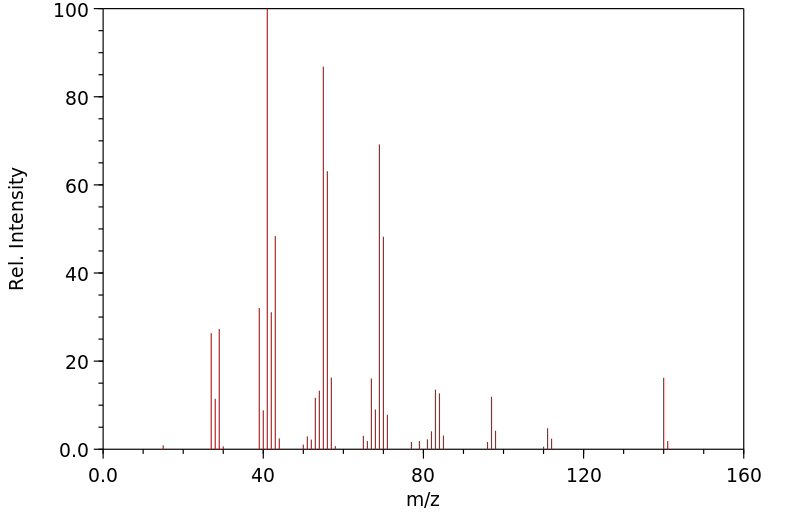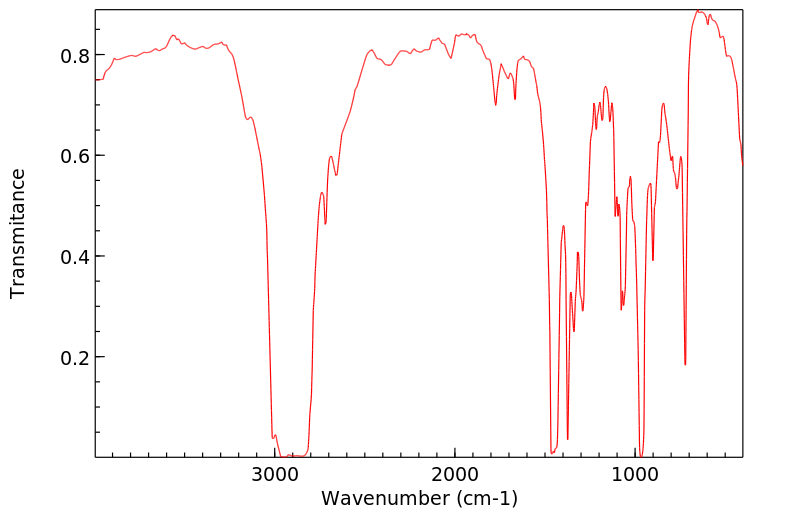反式3癸烯 | 19150-21-1
中文名称
反式3癸烯
中文别名
——
英文名称
trans-3-decene
英文别名
3-decene;3-Decen;dec-7-ene;(E)-dec-3-ene
CAS
19150-21-1
化学式
C10H20
mdl
——
分子量
140.269
InChiKey
GVRWIAHBVAYKIZ-FNORWQNLSA-N
BEILSTEIN
——
EINECS
——
-
物化性质
-
计算性质
-
ADMET
-
安全信息
-
SDS
-
制备方法与用途
-
上下游信息
-
文献信息
-
表征谱图
-
同类化合物
-
相关功能分类
-
相关结构分类
物化性质
-
熔点:-56.93°C (estimate)
-
沸点:166.82°C (estimate)
-
密度:0.7631 (estimate)
-
保留指数:993;994;995;996;994;995;986;1000.8;995
计算性质
-
辛醇/水分配系数(LogP):4.7
-
重原子数:10
-
可旋转键数:6
-
环数:0.0
-
sp3杂化的碳原子比例:0.8
-
拓扑面积:0
-
氢给体数:0
-
氢受体数:0
SDS
上下游信息
-
上游原料
中文名称 英文名称 CAS号 化学式 分子量 顺式-5-癸烯 cis-5-decene 7433-78-5 C10H20 140.269 辛烯 oct-1-ene 111-66-0 C8H16 112.215 正癸烯 1-Decene 872-05-9 C10H20 140.269 反式-1-碘-1-辛烯 (E)-1-iodo-1-octene 42599-17-7 C8H15I 238.112
反应信息
-
作为反应物:参考文献:名称:An efficient didehydroxylation method for the biomass-derived polyols glycerol and erythritol. Mechanistic studies of a formic acid-mediated deoxygenation摘要:发现了一种高效的1,2-脱氧方法,涉及一种意外的机理,适用于简单二醇和生物质衍生多元醇(甘油和赤藓糖醇),能够将1,2-二羟基转化为碳-碳双键。DOI:10.1039/b907746d
-
作为产物:描述:(3R*,4R*)-decane-3,4-diol 在 甲酸 作用下, 以83%的产率得到反式3癸烯参考文献:名称:An efficient didehydroxylation method for the biomass-derived polyols glycerol and erythritol. Mechanistic studies of a formic acid-mediated deoxygenation摘要:发现了一种高效的1,2-脱氧方法,涉及一种意外的机理,适用于简单二醇和生物质衍生多元醇(甘油和赤藓糖醇),能够将1,2-二羟基转化为碳-碳双键。DOI:10.1039/b907746d
文献信息
-
Organometallic Chemistry sans Organometallic Reagents: Modulated Electron‐Transfer Reactions of Subvalent Early Transition Metal Salts作者:John J. Eisch、Xian Shi、Joseph R. Alila、Sven ThieleDOI:10.1002/cber.19971300903日期:1997.9reductant, titanium dichloride, has been throughly examined, as well as the analogous ZrCl2 and HfCl2 reagents, all of which are readily obtainable by the alkylative reduction of the Group tetrachloride by butyllithium in THF. Noteworthy is that such interactions of MCl4 with butyllithium in hydrocarbon media lead, in contrast, to M(III) or M(IV) halide hydrides. Analogous alkylative reductions in THF低价,早期过渡金属试剂在有机化学中作为选择性还原剂的潜力已通过对MCMurry反应及其众多变体中产生的不明确且不均一的亚价钛中间体的深入研究而得以预示。作为开发对有机底物具有调制和选择性活性的可溶,定义明确的过渡金属还原剂的长期研究工作的一部分,已彻底检查了可溶于THF的还原剂二氯化钛以及类似的ZrCl 2和HfCl 2试剂,通过在THF中用丁基锂对四氯化物进行烷基化还原,很容易获得所有这些试剂。值得注意的是,MCl 4的这种相互作用相反,在烃介质中用丁基锂制得的M(III)或M(IV)卤化物氢化物。应用于VCl 4,CrCl 3和MoCl 5的THF中类似的烷基化还原反应产生的还原剂与从MCl 4获得的还原剂相似,但反应活性分级。已证明这种还原剂能够以与涉及两电子转移(TET)的氧化加成一致的方式偶联羰基衍生物,苄基卤化物,乙炔和某些烯烃。这种反应途径与观察到的由酮形成频哪醇的立体化学以及炔烃的还原性二聚化相一致。与CrCl
-
γ-Selective allylic substitution reaction with Grignard reagents catalyzed by copper N -heterocyclic carbene complexes and its application to enantioselective synthesis作者:Satoshi Tominaga、Yukinao Oi、Toshio Kato、Duk Keun An、Sentaro OkamotoDOI:10.1016/j.tetlet.2004.05.135日期:2004.7The reaction of allylic compounds with alkyl Grignard reagents in the presence of a catalytic amount of copper N-heterocyclic carbene (NHC) complexes proceeded predominantly in an SN2′ reaction pathway to give γ-substituted product in excellent yield. The method was applied to asymmetric reaction by using optically active NHC ligands.
-
A Selective Ru-Catalyzed Semireduction of Alkynes to Z Olefins under Transfer-Hydrogenation Conditions作者:Christian Belger、N. Matthias Neisius、Bernd PlietkerDOI:10.1002/chem.201001143日期:2010.10.25By using a readily available, air‐ and moisture‐stable dihydrido–Ru complex, a variety of Z olefins are accessible under transfer‐hydrogenation conditions with formic acid as the hydrogen source in excellent yields and Z/E selectivities.
-
Efficient Epoxidation of Alkenes with Aqueous Hydrogen Peroxide Catalyzed by Methyltrioxorhenium and 3-Cyanopyridine作者:Hans Adolfsson、Christophe Copéret、Jay P. Chiang、Andrei K. YudinDOI:10.1021/jo005623+日期:2000.12.1The epoxidation of alkenes with 30% aqueous hydrogen peroxide is catalyzed efficiently by methyltrioxorhenium (MTO) in the presence of pyridine additives. The addition of 1-10 mol % of 3-cyanopyridine increases the system's efficiency for terminal and trans-disubstituted alkenes resulting in high isolated yields of the corresponding epoxides. The system allows for epoxidation of alkenes with various
-
Anti-Markovnikov Hydroheteroarylation of Unactivated Alkenes with Indoles, Pyrroles, Benzofurans, and Furans Catalyzed by a Nickel–<i>N</i>-Heterocyclic Carbene System作者:York Schramm、Makoto Takeuchi、Kazuhiko Semba、Yoshiaki Nakao、John F. HartwigDOI:10.1021/jacs.5b08039日期:2015.9.30benzofurans, and furans, to unactivated terminal and internal alkenes. The reaction is catalyzed by a combination of Ni(COD)2 and a sterically hindered, electron-rich N-heterocyclic carbene ligand or its analogous Ni(NHC)(arene) complex. The reaction is highly selective for anti-Markovnikov addition to α-olefins, as well as for the formation of linear alkylheteroarenes from internal alkenes. The reaction occurs
表征谱图
-
氢谱1HNMR
-
质谱MS
-
碳谱13CNMR
-
红外IR
-
拉曼Raman
-
峰位数据
-
峰位匹配
-
表征信息
同类化合物
高密聚乙烯
香叶醇
顺式3-甲基-2-己烯
顺式-5-癸烯
顺式-5-甲基-2-己烯
顺式-5-庚烯-1-炔
顺式-4-癸烷
顺式-4-甲基-2-戊烯
顺式-4-甲基-2-戊烯
顺式-3-癸烯
顺式-3-甲基-3-己烯
顺式-3-甲基-2-庚烯
顺式-3-戊烯-1-炔
顺式-3,4-二甲基-3-己烯
顺式-3,4-二甲基-2-戊烯
顺式-3,4-二甲基-2-戊烯
顺式-2-甲基-3-己烯
顺式-2-壬烯
顺式-2-丁烯-D1
顺式-1.1.1-三甲基-2-丁烯
顺式-1-甲基-2-环丙基乙烯
顺式-1-甲基-2-乙烯基环戊烷
顺式-1-环戊基-1-辛烯
顺式-1-氘代-3-甲基-1-丁烯
顺式-(9ci)-2,3,3a,7a-四氢-4-(1-甲基乙基)-1H-茚
顺式-(2-丁烯基)环丙烷
顺式,顺式-2,4-己二烯
顺-环辛烯
顺-9-二十一碳烯
顺-6-十三碳烯
顺-5-甲基-1,3,6-庚三烯
顺-4-辛烯
顺-4-壬烯
顺-3-辛烯
顺-3-甲基-2-戊烯
顺-3-壬烯
顺-3-十三碳烯
顺-2-辛烯
顺-2-癸烯
顺-2-戊烯
顺-2-庚烯
顺-2-己烯
顺-2-丁烯
顺-2,2-二甲基-3-己烯
顺-1,3-戊二烯
顺,顺-1,9-环十六烷二烯
顺,顺,顺-环癸-1,3,5-三烯
间戊二烯
间二(4-吡啶基)苯
镁,二-2-丁烯基-








